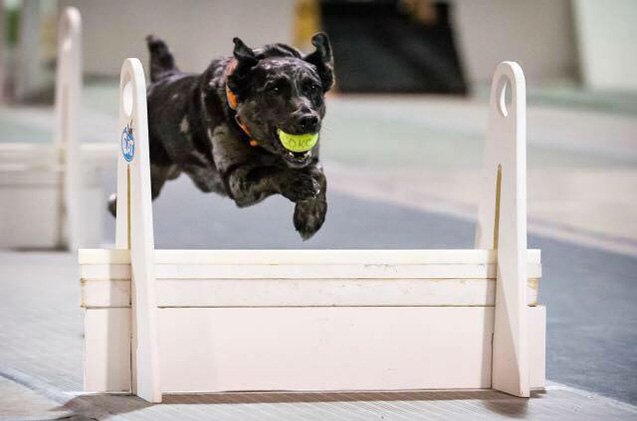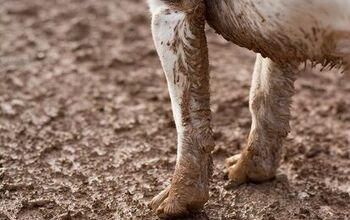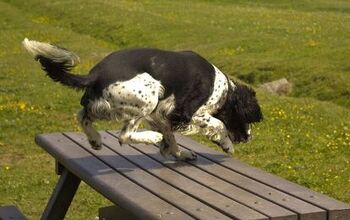5 Foot-Friendly Tips That Will Save Your Athletic Dog’s Paws

I love seeing performance dogs in action. It can be high-driving dogs, jumping off docks, racing down the flyball lanes, speeding along with a skier in tow, or climbing a peak in the back country. A well-trained dog, doing something he loves to do, is a beautiful thing to watch. It’s just one of the reasons why it’s so upsetting to see a dog sidelined because of an injury. Like human athletes, some injury in athletic dogs is to be expected. And thanks to advances in science and medicine, we’re able to better understand how to treat and prevent injuries in canine and human athletes alike.
Oftentimes, strong, hard-driven dogs will work so hard they’ll blow a paw pad. Blowing a paw pad means that layers of skin will be ripped right off of the dogs pads as they run across a surface. Some surfaces are worse for this than others. Rough rocks, hard rubber mats, pavement and sand right after a rain are all hard on a dog’s feet, often resulting in cut or blown paw pads. Other factors that come into play are the speed that the dog is travelling, the hardness of the surface, the amount of resistance (if the dog is pulling against a harness, under the load of a heavy pack, or being held back at the start line) and the condition of the dog’s foot.
Related: Safety Tips For Dog Paws
Keeping the dogs foot in proper condition will go a long way towards preventing paw pad injuries. In addition to basic foot care like trimming hair and filing nails, I use a five-point plan to keep my athletic dogs’ paws in tip-top shape.
Long Walks
Not only do dogs enjoy walks, it’s good for them. In many sports, dogs are put through amazing exercise programs that keep them fit and lean, in top performance for their chosen sports. Their bodies are conditioned into finely tuned machines, capable of performing the most amazing tasks, all without regular walks. However, don’t underestimate the power of a walk to help condition a dog’s feet. Walking your dog, not running or carrying any weight over a variety of surfaces on a regular basis, will condition the paws. Dog paws are designed to travel. If you ensure that your dog’s route includes a variety of surfaces, his feet will naturally become conditioned to handle them. This helps toughen them up for the more extreme demands of your chosen sport.
Paw Wax
“Wax on. Wax off.” It’s a proven strategy – just ask Mr. Miyagi! Pick up a jar of a paw wax, which are sold under a variety of names. All of these paw waxes work to condition your dog’s feet and prevent cracks. Most people are familiar with the benefits of paw wax in the winter time, as it helps keep hair balls from forming between a dog’s toes. But applying wax, similar to how humans use hand cream, will help keep feet supple and resistant to cracking and damage. A well-waxed paw is able to move and adapt to runs on different surfaces without splitting and cracking. I compare a dog’s paw pad to a pair of leather shoes. If the leather is dried out and in poor condition, it will crack under stress. But if you polish the shoes and keep them in good shape, they are much better suited to the rigors of daily wear and tear. When choosing a paw wax, avoid using any product with alcohol, which will dry out the feet, instead of leaving them supple.
That said, here are a few things to keep in mind with paw wax:
- No, paw wax is not automatically harmful to your dogs. Of course your dog is bound to lick his paw. It’s sort of their gig and what they’re known for, licking themselves. And it’s likely that your dog will lick his paws and therefore, the paw wax by default. It’s okay. When you’re looking for paw wax for your dog, remember that it’s unlikely a company is looking to purposely be harmful for your dog and read the ingredients. Look at what will be going on your dog’s paw, and therefore, in his body and be sure they’re ingredients you can trust. One of our all-time faves is Mushers Secret. It’s pretty much a gold-standard when it comes to paw protection because it can help protect from sand, snow, ice, salt and hot concrete, to a degree. It’s made specifically for Canadian sled dogs (and you know they’re RUFF) and it’s a high-quality paw wax that will offer fantastic protection.
- That all said…keep in mind that paw wax will NOT toughen up their feet for protection or callus. In fact, paw wax is designed to do just the opposite. It’s designed to keep their paws crack-ree and soft and supple. That way there is less of a chance of splitting, cracking or infection, which will help your athletic good boy or girl continue their adventures. Paw wax is great, but not if you’re looking to ‘toughen their pads’ up.
- Paw Wax WILL melt. It’s wax, after all. Like a flame with a candle, heat with paw wax will make it runny. So it’s not like it’s super ‘protection’ so to speak when it comes to hot surfaces. Some will say it can help, and maybe they can, but on hot surfaces your dog will be working on for decent time periods, consider booties.
Fat Feet
At a time when the pet-obesity crisis is at an all-time high, it’s wonderful to see dogs involved in a variety of activities. Often these dogs are trim, with barely an ounce of fat on their bodies. But a little bit of body fat does have its benefits. Besides being a reserve source of energy for a hard working dog, a small amount of fat is stored in the foot pads of dogs. It serves to insulate their sensitive paws from the extremes of hot or cold surfaces, as well as give them a little bit of added padding as they run. Feeding your athletic dog a little more fat in their diet will not mitigate the damage of running on a hard surface, but it will have a cushioning effect.
Zinc Supplements
The benefits of dietary zinc are well known in the mushing world. Dietary zinc helps to toughen up a dog’s paws, nails and improve their coat. Good sources of zinc in a dog’s diet are commonly found in meat such as turkey, lamb, live and canned tuna. Some vegetables have it as well, such as apples, raw carrots, baked potatoes, sweet potatoes and peanuts. If your dog is experiencing blown pads, consider adding a commercial zinc supplement his diet. There is a level of toxicity associated with zinc, however, there is no way to store Zinc in the vital organs. That means toxic levels of zinc must come from one time, large doses, not from an appropriate supplement. And it’s always good advice to keep any dietary supplement containers far out of your dog’s reach.
Routine Inspection
Inspect your dog’s feet regularly. By regularly, I mean make it part of your training routine. Check your dog’s paws after every activity. This gives you a healthy paw baseline, and you can be on top of any potential problems before they become larger injuries. To do so, gently spread their toes apart and inspect. Look at the sides of their paw pads and betweenn their toes to make sure no ickies decided to travel along (rocks, pepples, foxtails or thorns). See if your dog’s paws are swollen or have any discoloration that may be a sign of injury or infection. Many dogs will not necessarily love that you’re looking at their toesies, but if they seem to have tenderness or pain when you’re looking, that’s a sign of possible problem too. The more you look and inspect, the sooner you’ll catch the issues that may be there.
Remember – a dog’s paw pads are not indestructible. Follow my simple steps of walks, wax, fat and zinc, and you and your dog will spend more time playing, and less time worrying about blown pad pads and injuries. See a vet if you have even the slightest concern about the health of your dog’s paws. The sooner you do, the better.

Kevin Roberts lives for adventure. Together with his pack of rescue dogs and his husband, he spends as much time outdoors as possible. Kevin lives by the motto: "Get outside and play with your dogs!
More by Kevin Roberts


























